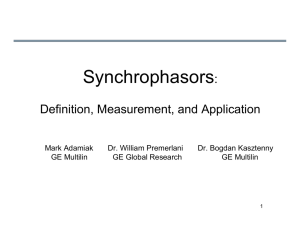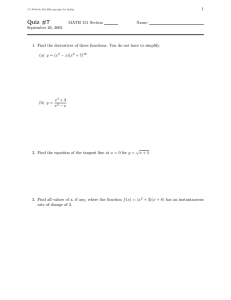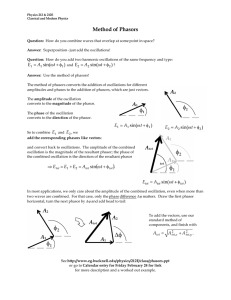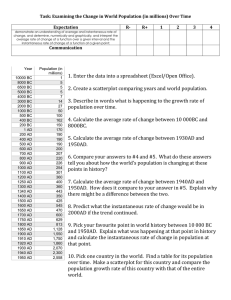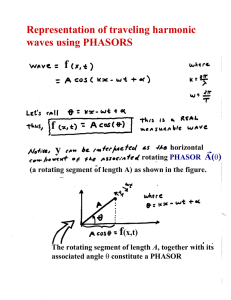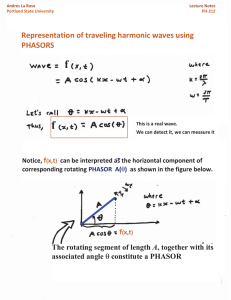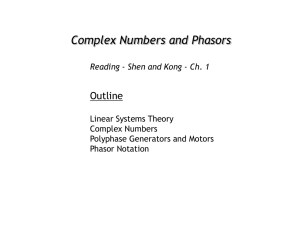Active Power Components of Instantaneous
advertisement
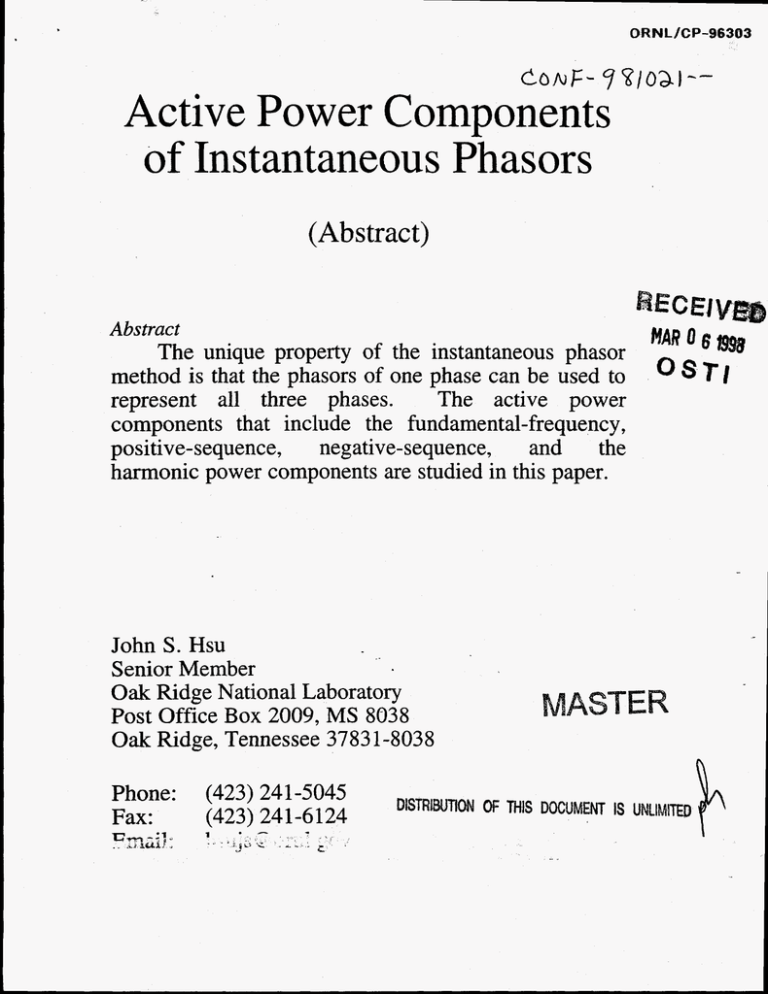
ORNL/CP-96303 Active Power Components of Instantaneous Phasors (Abstract) CEJ Abstract The unique property of the instantaneous phasor method is that the phasors of one phase can be used to represent all three phases. The active power components that include the fundamental-frequency, positive-sequence, neg ative-sequence, and the harmonic power components are studied in this paper. John S. Hsu Senior Member Oak Ridge National Laboratory Post Office Box 2009, MS 8038 Oak Ridge, Tennessee 37831-8038 Phone: Fax: c-11, .aura, (423) 24 1-5045 (423) 241-6124 . . _ - _- t 1 - I f b i i > i %# NAR 0 8 osr/ DISCLAIMER This report was prepared as an account of work sponsored by an agency of the United States Government. Neither the United States Government nor any agency thereof, nor any of their employees, makes any warranty, express or implied, or assumes any legal liability or responsibility for the accuracy, completeness, or usefuIness of any information, apparatus, product, or process disclosed, or represents that its usc would not infringe privately owned rights. Reference herein to any specific commercial product, process, or KMCCby trade name, trademark, manufacturer, or otherwise does not necessarily constitute or imply its endorsement, m m menduion, or favoring by the United States Government or any agency thereof. The views and opinions of authors expnssed herein do not necessarily state or reflect those of the United States Government or any agency thereof. DISCLAIMER Portions of this document may be illegible in electronic image products. Images are produced from the best available original document. PAPER DIGEST Active Power Components of Instantaneous Phasors John S. Hsu Senior Member Oak Ridge National Laboratory* Post Office Box 2009, MS 8038 Oak Ridge, Tennessee 37831-8038 Key words: Active power, Symmetrical propeq, Instantaneous phasor method, Phasors of one phase, Three Fundamental-frequency, Positive-sequence, phases, Negative-sequence, Harmonic power. where the zero-sequence component for the three-phase voltages is Abstract The unique property of the instantaneous phasor method is that the phasors of one phase can be used to represent all three phases. The active power components that include the fundamental-hquency, positive-sequence, negative-sequence, and the harmonic power components are studied in this paper. The real values of the instantaneous phasors are simply the instantaneous phase values without the zero-sequence component as given in (3). I. INTRODUCIlON The instantaneous phasor method originated by the author to solve power quality and efficiency of threephase systems with unbalanced and distorted voltages and currents has a unique symmetrical property. The phasors of one phase can be used to represent three phases[ 1,2]. . The power quality of a three-phase system can be indicated by the roundness of the trajectories of the voltage and current phasors [ 1, 21. The fundamental-frequency, positive-sequence components of the immediate past cycle can be obtained to guide the compensation of the present values. This approach for power quality improvement is different from the recent development of the instantaneous reactive power [3-51. The active power components of instantaneous phasors are studied in this paper. The instantaneous phasors of voltages and currents derived in [l] can either be presented in a vector format or in a complex number format. The arbitrarily chosen complex number format of the instantaneous phasors, such as the voltages, Vu,V, ,and V, ,are given in (1). They have the same magnitude but are 12O-degrees apart. _* _ ,._ - (3) The instantaneous phasors' imaginary values denoted as v u q , vbs ,and vCq can be obtained from (4) vuq =-'b - 6 ' ,and The numerators of equation (4) are actually the instantaneousline to line voltages that are not affected by the zero-sequence component. The instantaneous phasor magnitude, V, of Vu,V,, and V, can be derived from (2), (31, and (4). The result is that Prepared by the Oak Kiage7&uOnaI &&tory. dG &up. iennessee 3 1131,managed by Lockheed Martin Research Corp. for the U. S. Department of Energy under contract DE-AC05-960R22464. The submitted manuscript has been authored by a contractor of the U. S. Government under contract No. DE-AC05-960R22464. Accordingly. the U. S. Government retans a nonexclusive, royalty-free license to publish or reproduce the published form of this contribution, or ailow othen to do so. for U. S. Government purposes. PAPER DIGEST Where 381.589 Alternatively, the instantaneous phasor magnitude, V , of V,, vb, and V , can be derived from a phase, for instance, from phase-a II. TRAJECTORIES OF INSTANTANEOUS PHASORS The voltages and currents obtained from a field test of a 7.5-hp, 4-pole induction motor are shown in Fig. 1. The voltages are slightly unbalanced, and the currents are significantly more unbalanced. -385.3 17 385.358 Fig. 2 Trajectory of instantaneous phasors, Vu,v b , and V,. 14.591 16 0 -16.061 Fig. 3 -16 15.97 Trajectory of instantaneous current phasors, I,, Ib and I,. I Fig. 1 Phase voltages and currents at full load The trajectories of instantaneous voltage phasors, Vu,5,and 5,of (1) are shown in Fig. 2, where the three the trajectories of instantaneous current phasors, ia, ib, and i,, shown in Fig. 3. Figs. 2 and 3 also show that for the polluted voltages and currents, the instantaneous phasor trajectories constant speed [I, 21. The six peaks shown in the current trajectory suggest a strong fifth or seventh harmonic content. PAPER DIGEST The unique symmetrical property of the instantaneous phasors of three phases permits taking the voltage and current phasors of one phase to calculate the various power components of the entire motor. The trajectories of instantaneous phasors shown in Figs. 2 and 3 can be broken down into the phasors for various frequency components. Subsequently, the phasors of each fkquency component can be further broken down into positive and negative-sequence phasor components. Fig. 4 shows the flow chart for obtaining the fundamental three-phase balanced components. The bottom left of the figure is the input example of three phase voltages, vn, vb, and v,. Accordingly, the phasor-a imaginary portion, vq , and the real portion, va - vo, can be calculated through (3) and (4). Consequently, the instantaneous phasor magnitude, V, is computed from (6) or (7). 1 74:zrr magnitude, V , imaginary positive and negative peaks (49apart from zero-crossing points) band pass IFFT harmonic are of interest, a low-Q filter that normally has fast response is good enough. The positive and negative peaks of the second harmonic are 45degrees apart from the zero crossing points and are used to find the initial and synchronization phasors’ positions. Alternatively, a FFT may be used for the same purpose. The theory given in [2] is briefly described as follows. The maximum and minimum peaks of the second harmonic correspond to the in-phase positions of the fundamental-kequency positive and negative sequences [2] as shown in Fig. 5. When the positive-sequence phasor and the negative-sequence phasor coincide in the same direction, the instantaneous phasor has the maximum magnitude (points B and D) and is in phase with the positive-sequence component. When the positivesequence phasor and the negative-sequence phasor coincide in opposite directions (points A and C), the instantaneous phasor has the minimum magnitude and is again in phase with the positive-sequence component. I 1 Read filtered ‘i‘ i 1 fundamental filtermr FFT ,average phasor c I (1) initial and synchronization phasors positions (2) equivalent rmr phase currents (3) positive-sequence value, and (4) I negative-sequence phasor magnitude Fig. 5 fundamental 3-phase balancei comuonents Maximum and minimum magnitudes of fundamental-frequencyinstantaneous phasors The fundamental voltage and current phasors of phase a are given in Figs. 6 and 7. They are not in perfect circles because of the unbalanced voltages and currents [5]. Their positive and negative-sequence components can be b, P The second harmonic of the instantaneous phasor can be obtained through a sesond-order-harmonicband pass filter. Since only zero crossing points of the second +- an example, the positive and negative-sequence trajectories [2] of the current instantaneous phasor are illustrated in Fig. 7. Subsequently, the positive-sequence power a d negative-sequence power, which equals the fundamental- PAPER DIGEST frequency power minus the positive-sequencepower, can be obtained. The three-phase instantaneous active power, p , calculated from the real instantaneous voltages and currents is This is compared with the three-phase instantaneous power, pphosorrcalculated from the active voltages and currents projected from the instantaneous phasors. -360.71 1 Fig. 6 360.71 1 Trajectory of fundamental-frequency,phase-a voltage instantaneous phasor, Vu,. We have the three-phase instantaneous power P = Pphasor + 3v0i0. (10) 2. N o Average Power Produced from Harmonics Interacting with Fundamental Components The higher orden of harmonics interacting with the fundamental components do not produce net power over the time period of one fundamental cycle. This can be proven as follows. (sin wIt.sin N q t ) dolt -1 1.883 Fig. 7 1 1.883 Trajectories of fundamental-frequency,phase-a current, I,, , and its positive and negative- ILI. ACTIVE POWER COMPONENTS I . Three-phaseInstantaneousActive Power where the first sine term, sinw,?, is the fundamental component; the second sine term, sinNo,t, is the harmonic component; W, is the fundamental angular frequency; t is time in seconds; and N is an integer greater than one. ge and current phasors having constant magnitudes and rotating at a constant angular fiquency. a,are shown in Fig. 8. The average power associated PAPER DIGEST with these voltage and current phasors over a time period of the angular frequency, W , is Average power fundamental cycle naturally covers all the higher order harmonics. Use N c to denote the number of data taking per cycle, and n to denote the sequence of taking the data. The function, arg, means argument. The average power can be written as 1 - 1 Illu Ilcos(a) = IlVa 2 1 =-va .la, 2 where the magnitudes of the phasors are IIV,IIand Il1,II. Equation (12) indicates that the average power is equal to half of the dot product of the voltage and current phasors, or to half of the product of their magnitudes multiplied by the cosine of the angle, a,between the phasors. This manner of calculating average power from the instantaneous voltage and current phasors will be used in the calculations for various power components. 5. Positive-Sequence and Negative-Sequence Average Power Componem are lndependentfrorn Each Other The fundamental-frequency, three-phase, positive and negative-sequence, instantaneous voltage and current phasors are shown in Fig. 9. The suffix, P, is for the positive sequence, and the suffix, N, is for the negative sequence. NJN U IC P real L ViG- w i 3\ trajectones Fig. 8 Voltage and current phasors with constant magnitudes and rotating at a constant angular frequency, 0. 4. Average Power of Immntaneous Phasors Because of the unique property of the instantaneous phasors, any one phase, such as the phase-a average power, represents one third of the average threephase power. In general the trajectory of an instantaneous phasor is not a circle, and the phasor’s angular frequency is not a constant. However, at a given time instant, the innstantanenas uhasors can be viewed as a set of the instantaneous averaged power of the phase-a instantaneous phasors over a fundamental cycle. The Fig. 9 Fundamental-frequency,positive and negativesequence instantaneous phasors The products of currents and voltages that contain positive and negative-sequence components yield two independent positive-sequence and negative-sequence power components as verified by the following derivation. c PAPER DIGEST This equation can be simplified as follows. Other harmonic powers, such as the fifth harmonic power can also be obtained in a like manner as demonstrated for the calculations of hndamental-frequency power components. IV.CONCLUSIONS 3 = - Vap 2 lap + 73 Vu, 0 The unique property of the instantaneous phasor method is that the phasors of one phase can be used to represent all three phases. The active power components that include the fundamental-frequency, positive-sequence, negative-sequence,and the harmonic power components m studied in this paper. I,, V. ACKNOWLEDGMENT (15) Equation (15) shows that because of the unique symmetrical property of the three-phase instantaneous phasors, the power components of three-phase can be obtained through the phasors of one phase. Two independent positive-sequence and negative-sequence power components are obtained. The summation of following terms in the derivation of Equation (15) is zero. Encouragement from the Power Electronics Group headed by Mr. Donald Adams and the helpful discussions from Dr. John McKeever are gratefully acknowledged. VI. REFERENCES [I] John S. Hsu, “Instantaneous Phasor Method for Obtaining Instantaneous Balanced Fundamental Components for Power Quality Control and Continuous Diagnostics,” Paper Number: 98WM360, Power Engineering Society Winter Meeting, 1998, Tampa, FL. [2] John S. Hsu, “Instantaneous Phasor Method Under Severely Unbalanced Situations,” Paper Number: 98SM202, Power Engineering Society Summer Meeting, 1998, San Diego, CA. [3] H. Akagi, Y. Kanazawa A. Nabae, “Instantaneous Reactive Power Compensators Comprising Switching Devices without Energy Storage Components,” IEEE Trans. Ind. Appl., Vol. 20, pp. 625-630, May/June 1984. [4] A. Nabae and T. Tanaka, “A New Definition of Instantaneous Active-ReactiveCurrent and Power Based on Instantaneous Space Vectors on Polar Coordinates in Three-phase Circuits,” EWES Winter Meeting, Paper NO. 96WM227-9 PWRD, 1996. [5] F. 2. Peng and J. S. Lai, “Reactive Power and‘ Harmonic Compensation Based on the Generalized %5w-F&&qp Incem-&rs.d Conrerence on harmorucs and Quality of Power, pp. 8389, Las Vegas, NV, October 1618,1996. =O r+ c ' PAPER DZGEST VII. APPENDIX is derived from the fundamental-frequency, instantaneous phasors shown in Figs. 6 and 7. Various power components of the sample case are calculated as examples. The number of data taking, N c , is ar&itrariiy chosen as 84 per fundamental cycle in the calculations. e = 6,094 W. The sample yields I . Total Power Averaged Over a Cycle The three-phase total active power given by (8) is averaged over a fundamental cycle. The positive-sequence, fundamend power component refemng to (12), Zulp of Fig. 7, and Vu,, (not shown) is This average total power yields eo,,,,= 6,099 W. - arg(luIp rill- ) - (nV1ma.x- nllmax)-l27r N, 2. Total Power Defined by ( l o )Averaged Over a Cycle 1 N. (17) It results in E&tal = 6,099 W. where n = nV1 max is the data-taking sequential number corresponding to the maximum magnitude of fundamentalfrequency voltage phasor at point B or D shown in Fig. 5 , and n = nV1 min corresponds to the minimum magnitude of voltage phasor at point A or C shown in Fig. 5. The similar meanings of n = nll max and n = nll minare for the current phasors. Where from (9) and (1 3) the first summation term in (17) For the sample data Fip = 6,067 W. is (18) This term yields 6,097 W for the sample- The instantaneous phasors, V, andl,, of the example are shown in Figs. 2 and 3. The second summation term of (17) is the average zero-sequence power component, 1 Nc - C WO, io,). N, n=l This term yields 2 Watts. The zero-sequence component, vo, is dehed by (2), and is evaluated in a likp ~ p n n 9s - ~qiver! i n 131 The fundamental-frequency power, 8 , that includes positive and negative-sequence power components The fundamental-frequency, negative-sequence power is the difference of fundamental-ikquency power and its positive-sequence component. It gives 27 Watts for the sample case. The fundamental-frequency, negative-sequence power can also be presented in a format similar to (21).

